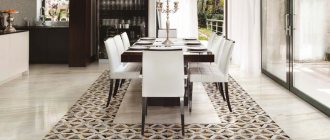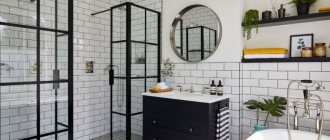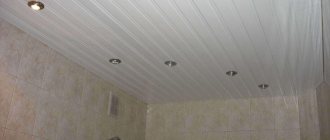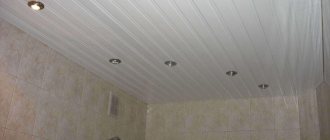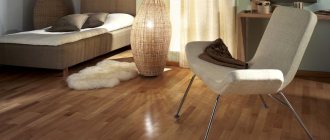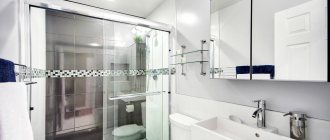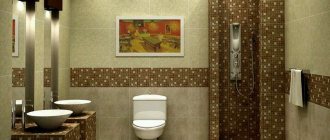Home/Interior and design/Floor tiles for the kitchen (100 design photos)
In the process of choosing flooring for the kitchen, it is necessary to take into account the fact that this room gets dirty very quickly and requires careful and frequent cleaning. That is why the flooring material must be practical. The ideal solution is choosing kitchen floor tiles. Photos of designs with kitchen floor tiles are presented below.
What you need to lay floor tiles
Just three things:
- Floor tiles;
- Glue for installation and grout for seams;
- Tool.
And, of course, your desire. But in order to choose the right material, which is not only beautiful to look at, but also most suitable for operating conditions, you should immediately talk about its characteristics.
All tiles differ in size, color and patterns, physical properties and other components that characterize the area of its application.
Color and tone
It is important to know here that the tiles can differ significantly in shade if they are from different batches. The store must be warned about this. A responsible manufacturer marks the product with special markings.
Before purchasing, you should make sure that each box has the same symbol of the product type.
What to do if the tiles are still different or the purchased material was not enough and you had to buy another package from a different batch. Some design tips:
- choose the closest possible tone;
- calculate the masonry so that the visible part of the floor is the same;
- hide the boundaries of difference under the kitchen set and other furniture.
To avoid such problems, it is better to make sure in advance that all products are the same color, but to do this you will have to open the packaging.
Expert opinion
Olga Kovalenko
Since 2010 I have been engaged in interior design and architectural design.
For the kitchen, it is better to choose tiles with a matte finish, which are more practical to use.
What you need to know about tiles
The main requirements for the entire tile series are:
- Frost resistance;
- Water absorption;
- Wear resistance (IV class);
- Resistance to chemically active substances;
- Fire resistance and fire resistance;
- Slip resistance.
Here are several criteria by which floor tiles should be selected for different rooms.
- Kitchen floor tiles. The floor in this room is constantly exposed to frequent contact with grease and oils. Therefore, it requires tiles with increased resistance to detergents. Plus, quite frequent visits to the kitchen by a person require a high wear resistance class of tiles (not lower than III).
- Floor tiles for the hallway. Darker tones of colors are desirable, because dirt on them is not so noticeable. In addition, the floor of this room will constantly be exposed to shoe soles and heels of women's shoes. Cases of exposure to heavy objects brought in from the street, for example, suitcases with metal legs, children's sleds, etc. are also not uncommon. Therefore, the degree of wear resistance of the coating must be at least class III.
- Bathroom floor tiles. Constant high humidity forces bathroom tiles to be laid in a manner that has a low degree of moisture absorption. Its textured surface will also be important, allowing it to provide good slip resistance.
Choosing a design
Wood or ceramic parquet
To imitate laminate, small rectangular tiles made of porcelain stoneware are often produced. Ceramic is more suitable for imitation parquet.
Aged wood flooring in a loft style kitchen
This design will be an ideal solution for a classic or industrial-style interior.
Under the stone
Most often, the same porcelain stoneware is chosen to imitate stone. With high-quality installation, it will be practically indistinguishable from its natural counterpart.
Multi-colored or patterned
You can combine colored or patterned tiles with plain ones.
A carpet made of tiles looks unusual and dilutes the minimalist design.
Too colorful is also better to combine with a plain, neutral one. Otherwise, you risk creating a feeling of chaos in the room.
Light tiles
Light-colored floors are more practical than dark ones, because stains, crumbs and other dirt are less noticeable on it.
Dark floor
A dark palette can be a bold design decision depending on the chosen style, but it is advisable to dilute the dark tones at least in small quantities.
Dark floor with contrasting, light grout
For a small kitchen
For small rooms, one that is not too large, without a bright pattern, mostly monophonic or containing no more than 3 colors is suitable. When choosing colors, preference should be given to light options.
A diagonal layout or herringbone will expand the space.
For a narrow kitchen, rectangular tiles with a transverse layout are suitable.
10 ideas for a kitchen in a private home
A private home is characterized by a large kitchen space, which allows the use of various installation options in combination with large and medium-sized tiles.
The design of the floor should be in harmony with other interior items: apron, furniture, accessories.
Here you can safely experiment with patterns.
Porcelain tiles for the kitchen
In addition, there is such a type of floor tile as porcelain stoneware. In its mechanical properties and appearance, it is very similar to natural granite.
In terms of wear resistance it has V, the highest class. With its help, both indoor floors can be perfectly decorated, tiles can be laid on steps outside the house, and the surfaces of open balconies and terraces can be tiled.
Tile adhesive
As has already become clear from the above, each tile has its own purpose. Therefore, the materials for its flooring must be suitable. Different manufacturers call adhesives differently.
Therefore, it is customary to roughly divide them into three types:
- Primary. Perfect for wall tiles and small floor tiles located in dry rooms;
- Reinforced. Used for laying large-format floor tiles and small porcelain tiles. Has a high degree of moisture resistance;
- For difficult surfaces. Designed for installation of any porcelain tile on concrete bases, old tiles and even glass. It can also be used for laying natural stone on the outside of a building or covering car showroom floor surfaces. Very durable. Not afraid of either moisture or frost.
Important! If floor tiles are being installed on a previous surface or on a surface with a large number of joints, then the top tiles should overlap the old seams.
Porcelain tiles
Porcelain tile is a relatively new material that is a more durable, advanced ceramic. Porcelain tiles are so durable and stable that they can be easily laid even outdoors, which means they will no doubt last a long time in the kitchen without any flaws! Porcelain tiles are not afraid of moisture, cleaning agents and fire. Thanks to improved production technology, slabs made from it can be simply huge in format: up to three meters in height. This will appeal to those who do not like tile seams that interrupt the pattern. The natural surface of this material is non-slip and matte. However, there are polished, glossy and structured options. With all these advantages, porcelain tiles have excellent aesthetic characteristics. In particular, it easily imitates more expensive and capricious materials such as natural marble or wood.
Marking
Having decided on the materials and adhesive mixtures, you can begin marking the room. But first you need to determine how to lay floor tiles in order to accurately calculate the required quantity.
The easiest option is to first draw everything on a piece of paper. It is best to use a computer layout program. Now there are many of them.
After purchase, it is recommended to lay at least part of the tiles “dry” on the floor and visually look at the result. You may need to adjust (move in one direction or another) the location.
Important! The tile is highly durable, but at the same time fragile. Therefore, it is recommended to buy it with a margin of 10-15%.
Disadvantages of tiled flooring
The disadvantages of using tiles include:
- Cold surface. You will have to wear slippers in the kitchen, especially in the winter. Installing a floor heating system will help solve this problem.
- The occurrence of chips from falling heavy objects.
- Slippery surface. You can encounter this drawback if you choose the wrong tile. There are many models on the market with a matte rough surface.
- Requires a perfectly flat and dry floor for installation. If you do not adhere to this condition, cracks will form in the kitchen.
- Low level of sound insulation. This problem can be solved by laying soundproofing material.
Advice! Relief tiles look very beautiful, but dirt is difficult to wash off from its surface.
Tile composition
If you plan to decorate a large room, you can create geometric shapes using different shades of tiles. Existing “borders” for tiles will help add contrast to monochromatic coverings or create zoning of an area.
There are even entire floor panels consisting of 4, 8, 9, 16 or more tiles with printed images.
In general, there are many decor options. It all depends on the availability of a good hardware store nearby, your own imagination and financial capabilities.
Options for laying tiles in the kitchen
You should also decide on the flooring technique. Today there are two rules for laying tiles. Namely:
- Seamless;
- With seam.
Seamless technology has appeared relatively recently. But despite this it has already gained popularity. The surface obtained in this way creates the effect of a certain solidity of the entire floor. But this option is not very easy for beginners.
- Firstly, in order for the floor to look impeccable, you need extremely smooth tiles with the correct geometry. Most of its cheap types, and sometimes some of the expensive ones, are guilty of this. Therefore, before laying, you should go through all the material and sort it by size. Otherwise, it will be impossible to hide flaws.
- Secondly, in the event of any even minor peeling, the resulting surface will begin to deteriorate very quickly. This method of flooring is best left to an experienced craftsman.
The suture technique has been used for quite a long time and is well known to everyone. In this case, there is a distance between the two mating tiles. As a rule, this is 1-3 millimeters.
To ensure that the seams are the same size, special crosses are used when laying. After the adhesive has dried, they are removed and the gaps are filled with a special tile grout.
Laying tiles diagonally
Options for laying floor tiles with a seam are divided according to the installation method.
There are three main ones:
- Seam to seam;
- In the dressing;
- Diagonally.
- The first one can be called classic. The tiles form rows in horizontal and vertical directions.
- The second involves pairing the tiles like a “brickwork” bond.
- And with the third, seams are formed in diagonal directions at an angle of 45 degrees relative to the walls.
Tools
To lay tiles, regardless of the base, mixtures used to level the floor, methods, adhesive tile compositions and other components, you will need a certain set of tools. Here he is:
- Flute brushes and paint brushes - for cleaning the surface for laying. You can also use a construction vacuum cleaner;
- Paint roller – for priming the floor;
- Tape measure, square, ruler - measuring tools. Will be needed all the time until the end of the flooring;
- Hydraulic level, tapping cord - will serve at the stage of marking the surface for laying;
- Rule-trapezoid, level, nylon thread - necessary to create precise horizontal lines and prevent differences in floor level;
- A drill with a mixing attachment and a deep container - you cannot do without their help when preparing the adhesive mixture;
- Spatula, notched trowel, trowel - tools for applying diluted mortar to the surface of tiles and floors;
- A rubber hammer is a tool for shrinking the laid tiles;
- Tile cutter, tile cutter, grinder with a disk for dry cutting - specific tile tools for cutting tiles in straight lines;
- Tile nippers - will be needed in case of removing small pieces of tiles (in particular corners) of irregular geometric shape;
- Ballerina is a tool for drilling even round holes of various diameters.
- Grouting compounds
Grouting tile joints
With the help of grouting compounds, the laid tiles acquire a finished look. With their help you can create an excellent contrast to the tiled surface.
It should be noted that in addition to the decorative function, the grout also has a very practical purpose - it protects concrete screeds or wooden floors under the tiles from moisture from the environment.
Today, the two most common types of such fillers are:
- Cement based;
- Based on resins (mainly epoxy).
- The first, in addition to cement, contain additives that increase ductility and water resistance. May contain coloring pigments. Designed for filling joints indoors. They are relatively inexpensive.
- The latter are usually two-component. They consist of resin and hardener itself, which, when hardened, form a very durable moisture-proof surface. They are used for grouting joints in all types of premises and even swimming pools.
It is also important that they resist temperature changes very well. Do not react to chemically active substances.
The only downside is the difficulty of working with them due to their viscosity and the difficulty of cleaning the tiles if they are applied incorrectly.
Laying floor tiles is a long and labor-intensive process. It has its own laws, specifics and rules. But if they are followed correctly and completely, the expected end result will certainly be achieved.
Advantages and disadvantages
You should consider the advantages and disadvantages of each individual type of ceramic tile.
| Material | pros | Minuses |
| Tile | Durability, reasonable price, long service life, ease of maintenance, environmental friendliness, fire resistance, damaged floor area is easy to replace | The material is cold and slippery and requires careful surface preparation before installation. It has low sound insulation |
| Porcelain tiles | Wear resistance, clear pattern, strength | Heavy slabs are very fragile and difficult to lay |
| Quartzvinyl | A floor made from this material is warm, non-slip, and easy to install. | Difficulty in transportation due to the heaviness of the slabs |
All shortcomings of any type can be corrected. Sound insulation will be enhanced by an additional layer of special material, cold tiles will be corrected by the “warm floors” system, and the textured surface will reduce slipping.
